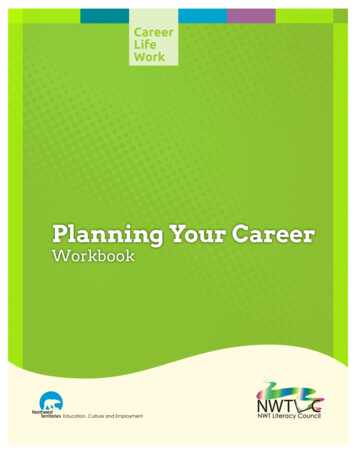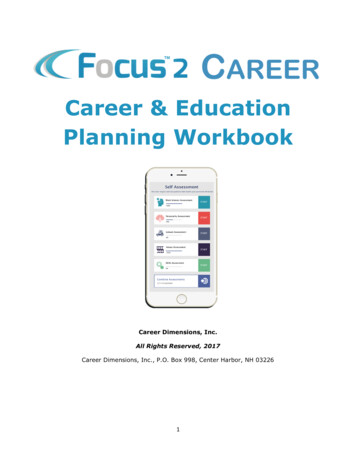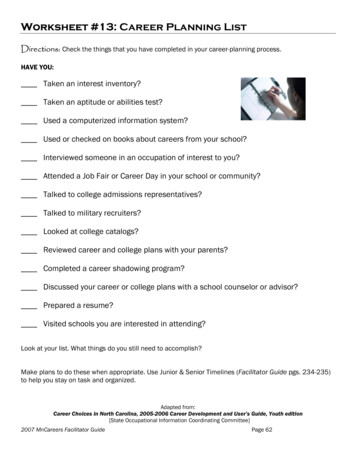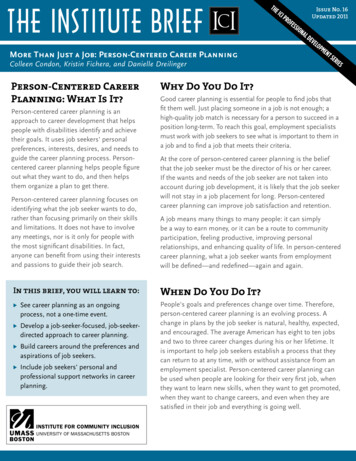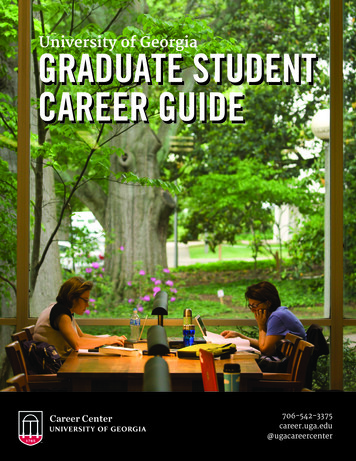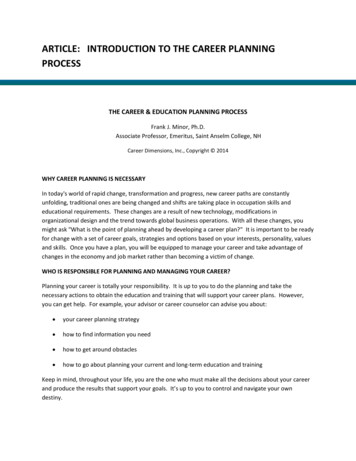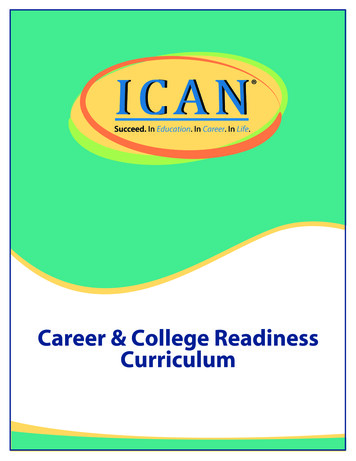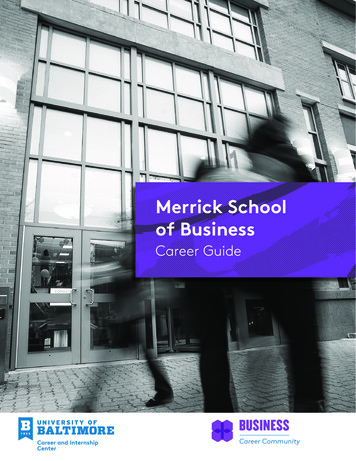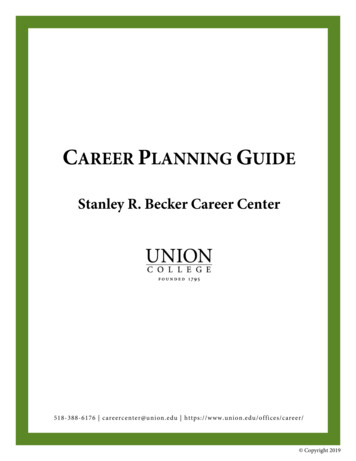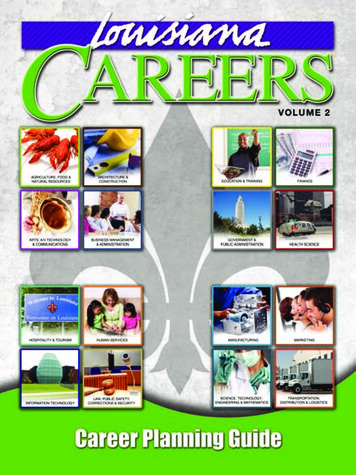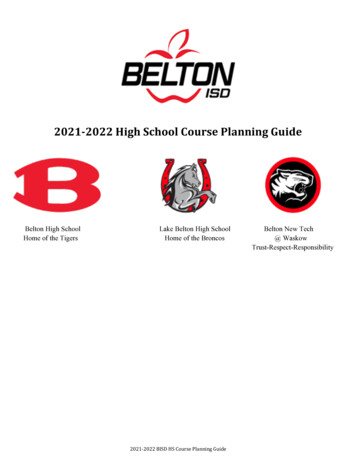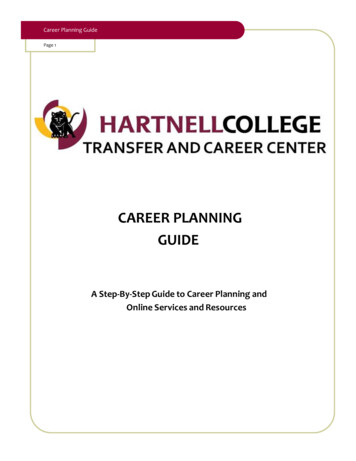
Transcription
Career Planning GuidePage 1CAREER PLANNINGGUIDEA Step-By-Step Guide to Career Planning andOnline Services and Resources
Career Planning GuidePage 2IntroductionPart 1: Self Exploration .6Part 2: Explore Career Pathways . . .10Part 3: Do the Research 12Part 4: Prepare .15
Program & ServicesPage 3TRANSFER AND CAREER CENTER PROGRAM & SERVICESProgram PurposeThe Transfer and Career Center of Hartnell College provides guidance in career and majorexploration, job preparation, and university transfer information. Through the support ofthe Transfer and Career Center, you will identify and use career resources and labor marketinformation to recognize your own skills, abilities, values, and interests. As a result, you willbe equipped to formulate your personalized career goal. You will also be able to navigatethrough the ASSIST program to identify and utilize transfer patterns from the University ofCalifornia and California State Universities to transfer successfully.We Provide: Career and Transfer Guidance Major and Career Exploration via Assessments Career Development Workshops: Resume, Cover-Letter, and Interviewing Local Employment Opportunities Information Career/Job-Fairs Job-Search ResourcesOFFICE HOURS&CONTACT INFOMonday-Thursday 9:00 a.m.-6:00 p.m.Friday(831) 759-60078:00 a.m.-5:00 p.m.@TransferCareerCollege Center, C-132www.hartnell.edu@hartnell transfer
Career Planning GuidePage 4THE CAREER PLANNING PROCESSChoosing a career path can be a confusing and intimidating process. However, throughresearch and preparation, this process is a benefit to your future success. The model belowshows the cyclical nature of career planning. You may have noticed that the process doesnot have a clear starting point nor does it seem to end. This is good news! It means thatcareer planning is a continual process that may begin and end at any point and is useful atany stage of your career development.
The Benefits of Career PlanningPage 5WHAT ARE THE BENEFITS OF CAREER PLANNING? You will spend more than 80,000 hours of your life working! Why spend it doingsomething you don't enjoy? The occupation you choose has a big impact on many aspects of your life. Narrowingyour choices somewhat helps to define your lifestyle and gives you a clearer pictureof who you are. Career exploration helps you learn more about yourself. Learning more about yourinterests and preferences enables you to form more meaningful relationships withfriends and significant others. People gain decision-making skills and occupational knowledge through career planningactivities. When you are faced with many, many career options, you may not take the time toexplore them in depth: instead, you may feel overwhelmed! Good decision-makers take time exploring options and are able to make informed,satisfying decisions. Career planning results in having realistic career goals. Students who engage in career exploration programs report higher grades and feelbetter prepared for the future compared to students who do not. Career exploration helps people face and find solutions to educational and careerbarriers. Career exploration helps people develop a support network and learn where to gowhen help is needed.Students who have completed career exploration have more confidence in themselvesand are more motivated to achieve their goals. The above information is used with the permission of ACT and is taken from the ACT DISCOVER CareerDevelopment Curricula for Colleges via www.tulsacc.edu
Career Planning GuidePage 6Part 1: SELF EXPLORATIONBefore You Begin These assessments are meant to help you in your career planning process. While theresults are accurate, they in no way represent who you REALLY are. That is a decisionthat only you can determine for yourself. Use these assessments as a starting point forpersonal reflection and critical thought about what you may want to do as a career, andthe kind of person you’d like to be in the future.I. Types of Self-AssessmentsListed below are some assessments to help you with self exploration. Choose at leasttwo assessments in EACH of these categories: Interests Assessments Personality Assessments Skills Assessments Values AssessmentsREMINDER: Remember to print and keep the results of your assessments in yourpersonal records. Once you’ve completed the assessments, you can compare theresults and see if there are certain career themes or patterns that emerge. Theserecurring themes may suggest career pathways that might fit best.
Personality AssessmentsPage 7II. Personality AssessmentsCareer planning is essentially a search for self. Personality assessments can help youbecome more self aware. They also offer insight into how you relate to the world and toother people. The results of some of these assessments may not point directly to careerchoices that might fit you, but they will give you ideas about what work environmentsmight be most compatible with your personality.A. Identify your Holland Personality Type, also called your RIASEC typecode, to find out how your personality preferences relate to interests andcareer fields.1. Go to the following website: California CareerZone2. Click on Discover Possibilities.3. Select the Quick Assessment.4. Complete the assessment and View Results for a list of jobs that match your3-letter RIASEC code.5. Remember to print your results for future reference!B. Take the free KTS-II Temperament Sorter.C. Take a free test that is based on Carl Jung’s and Isabel Briggs Myers’typological approach to personality and offered at the following website:Human Metrics.D. Take the free True Colors personality test.
Career Planning GuidePage 8III. Interest AssessmentsThe things you like to do can help you identify career fields to explore. As you do aninterest assessment, think about what you like or dislike doing, not about your ability to doit. Interest assessments help you identify preferences based on your likes and dislikes.After you have completed an assessment, be sure to make the career connection! Findout what career fields might match your interests. Print out the results for futurereference. It will be helpful to compare the results of different interest assessments andsee if there is a pattern as to what occupations are suggested.Notice that most interest-assessment surveys indicate your Holland type. Go to thiswebsite for more information about Holland types:Holland CodesA. California Career Zone1. Go to the following website: California Career Zone2. Hover over Explore and view Assess Yourself.3. Select the Interest Profiler.B. My Next MoveThis is an alternative online assessment to the Interest Profiler and will provide acomplete overview of compatible career choices and necessary training and/oreducation based on your assessment results.1. Go to My Next Move.2. Click on Start in the “Tell us what you like to do” box.
Personality AssessmentPage 9IV. Values AssessmentsValues are guiding principles or motivators that indicate what you consider mostimportant in your life. Your most important values are those that you prize the most,affirm publicly, choose freely after careful consideration and act upon consistently.Identifying your most important values will help you choose a career that will fulfill and becompatible with these values.A. To identify the characteristics of a job which are important to you:1. Visit California Career Zone.2. Hover over Explore and view Assess Yourself.3. Then click on the Work Importance Profiler.B. To help you identify and prioritize values that are important to you, completethe: Career Values AssessmentV. Skills AssessmentsA skill is an activity that you have learned to do well or that you can improve upon throughtraining and practice. What skills do you find most satisfying and enjoyable? These arethe ones that you may wish to use in future work.A. To identify your acquired skills:1. Go to the following website: California Career Zone.2. Hover over Explore and view Assess Yourself.3. Then click on the Skills Profiler.B. Which skills do you have? Use the Job Skills Checklist to help you determineyou abilities.
Career Planning GuidePage 10Part 2: EXPLORE CAREER PATHWAYSNow that you have an idea of your personality and interest traits, begin exploring thedifferent types of career industries and pathways that are available.California’s 15 Career Pathways:Agriculture &Natural ResourcesArts, Media &EntertainmentEducation, Child Care& Family ServicesEnergy, Environment& UtilitiesHealth Science &Medical TechnologyHospitality, Tourism& RecreationManufacturing &Product DesignMarketing, Sales,& ServiceBuilding &Construction TradesEngineeringArchitectureBusiness &FinanceFashion &Interior DesignInformation &Communication TechnologyPublic ServiceTransportationThe above information was gathered from the California Career Café website www.cacareercafe.com
Explore Career PathwaysPage 11The following online resources offer an in-depth overview of California IndustryPathways including a summary of the job, the duties related to that field of work, thelevel of education required, the average salary, a list of the college majors compatiblefor the job, and the California colleges and universities that offer those majors.A. California Career Café1. Explore California career pathways by going to:California Career Café2. Click Explore to beginB. California Career Zone1. Explore Industry Sectors by going to:California Career Zone: Job FamiliesC. My Next Move1. Browse careers by industry at the following website:My Next Move2. Under the “I’ll know it when I see it” box, select an industry you areinterested in or would like more information about.3. Click Browse to begin.
Career Planning GuidePage 12Part 3: Do the ResearchOnce you’ve identified a career pathway that might be of interest to you, do someresearch. Find out more about related occupations that match up with your selfassessment results. Here are some ways to gather information about career fields:1.Go Online:Go online to gather information about the careers you are considering:Occupational Outlook Handbook: This is a nationally recognizedsource of career information published by the Bureau of Labor Statistics.O*Net Online: This huge database, developed by the U.S. Departmentof Labor, includes information on skills, abilities, knowledge, workactivities and interests associated with thousands of occupations.California’s labor market information : Click on Job Seekers andStudents or California Occupational Guides.2. Visit the Transfer and Career Center at Main Campus:Go to the Transfer and Career Center located on the main campus in the StudentCenter, building C-132. The Transfer and Career Center provides career explorationservices and career development materials.3. Visit the Career Prep and Placement Services Office at Alisal Campus:Go to the Career Prep and Placement Services Center at the Alisal Campus locatedin office A111. This is the right place to start if you are a student or alumni andinterested in an internship, employment, or other career services.4. Visit the OneStop Career Center of Monterey County:The Monterey County Virtual OneStop is user-friendly and designed toconnect local employers and job-seekers.Visit Monterey County’s Virtual Job Center website.
Do the ResearchPage 135. Do Informational Interviewing:To gather real-life information, interview people who work in fields that are ofspecial interest to you.*Read the Informational Interviewing tips on the next page for moreinformation.You may also visit the following website for more suggestions about:Conducting an Information Interview.6. Volunteer:Gain work experience and learn new skills by helping others. Find volunteer tipsand opportunities through California Career Café .7. Intern:Internships are paid or unpaid, closely monitored, highly structuredemployment programs that provides professional work experience outsideof the classroom.Intern or work part-time in your prospective field. For more information, go toCalifornia Career Café.
Career Planning GuidePage 14For your informational interview, choose from the following questions:1. Background: Tell me how you got started in this field? What was youreducation? What educational background or related experience might behelpful in entering this field?2. Work Environment: What are the daily duties of your job? What are theworking conditions? What skills/abilities are utilized in your field?3. Problems: What are the toughest problems you deal with at work? Whatproblems does the industry as a whole have? What is being done to solve theseproblems?4. Lifestyle: What obligation does your work put on you outside the work week?How much flexibility do you have in terms of dress, work hours, vacations?5. Salary: What salary level would a new person start with? What are the fringebenefits? What are other forms of compensation (e.g. bonuses, commission,securities)?6. Potential: Where do you see yourself going in a few years? What are your longterm goals?7. Promotional: Is turnover high? How does one move from position toposition? What is your policy about promotions from within? How areemployees evaluated?8. Advice: When the time comes, how would I go about finding a job in this field?What experience, paid or volunteer, would you recommend? What suggestionsdo you have to help make my resume more effective?9. Hiring Decisions: What are the most important factors used to hire people inthis work (education, experience, personality, special skills)? How do peoplefind out about jobs?10. Do you have any additional advice for me?
PreparePage 15Part 4: PREPARENow that you have conducted research on possible career pathways, its time to put thosestrategies to work and begin looking for employment opportunities. Creating a professionalportfolio is a great way to highlight your professional skills and achievements. Your portfoliocould be a manila folder, a binder, or even a shoebox! The key is to have a designatedlocation where you can easily keep, update, and access important employment documents.A. Create a Professional PortfolioYour professional portfolio is a reflection and collection of your past professional andeducational experiences, awards, and achievements. Your portfolio should include:1. Resume2. Cover Letter3. Reference ListYour resume and cover letter are the key pieces within your portfolio. Your resume is a briefform that describes your education, employment history, and experiences that are relevantto the job you are applying. Your cover letter introduces you and your resume to a potentialemployer and provides an in-depth explanation of why you are the best candidate for theirorganization. The purpose of both your resume and cover letter is to secure an interview. Seethe following links for resume and cover letter writing resources and tips:A. Purdue Online Writing Lab (OWL) see Job Search Writing sectionB. UC Berkeley Career Center
Career Planning GuideRESUME TUTORIALPage 16Chronological FormatYour Namestudent@hartnell.edu Contact phoneUse an appropriateemail and voicemail.OBJECTIVE (optional)If included, it should be specific to the job you are applying forQUALIFICATIONS Number of years of relevant experience, noting skills gained An important accomplishment that directly relates to the job A quality or characteristic of yours that supports this goalA Qualifications section isoptional. Use only if you havesignificant skills that relate tothe job description.SKILLS Demonstrated experience with Proficient in EDUCATIONHartnell CollegeAssociate of Arts/Science, Name of MajorOverall GPA and/or Major GPA (only if above 3.0)Related Coursework: Course Title, Course Title, Course TitleGraduation date: Mo/YrEXPERIENCEPosition TitleMo/Yr – Mo/YrCompany/Organization Name, City, State Use bullet points to describe your accomplishments (paragraphs can work as well, although bullets will lead the reader’seyes easier) Always start your statement with “action verbs” – add adjectives to emphasize State an accomplishment that demonstrates your skills in this field/position Illustrate a problem you solved using relevant skill(s) and the results An example of when you used your skills to positively affect the organization, the bottom line, your boss, or your clientsLeadership TitleStudent Organization, School A project you’re proud of that supports your objective Quantifiable results that point out your skills Awards, commendations, publications, etc. that speak to your accomplished skillMo/Yr – Mo/YrVolunteer TitleMo/Yr – Mo/YrCommunity Service Organization, City, State Be consistent with punctuation and format Use present tense verbs for current positions and past tense verbs for previous positionsREFERENCES Available upon request.
Resume SampleRESUME SAMPLEPage 17Chronological FormatJane Panther(831) 555-5555 student@hartnell.eduEDUCATIONHartnell CollegeMajor: Associate of Science Degree in BiologyGPA: 3.54(12/14)Coursework: General Chemistry, Organic Chemistry, Biology, Biology of Human Reproduction, ComparativeEndocrinology, Hormones and Behavior, Physics, CalculusLAB SKILLSNuclear Magnetic ResonanceMass SpectrometryGel ElectrophoresisOrganic SynthesisThin Layer ChromatographyPolymerases Chain ReactionsDissectionInclude a summary of lab skills foran employer to quickly showcaseyour skills.EXPERIENCEChemistry Tutor(9/12-Present)Tutorial Center, Hartnell College Work with a team of experienced students to tutor both individually and in groups in subjects such as General Chemistry and OrganicChemistry Prepare mock lectures to teach complex Organic Chemistry reactions to Hartnell students Develop original problem sets to further illustrate concepts; well-received by studentsGrader (Chemistry lab)(9/11-5/12)Hartnell College, Salinas, CA Meticulously checked and graded over 100 lab books per week, paying close attention to details and returning to professor on time each weekVOLUNTEERVolunteer, Urgent Care at Salinas Valley Memorial Hospital(7/12-Present)Salinas Valley Memorial Hospital, Salinas Using care and compassion, assist healthcare providers and nursing staff with patient care Direct patients and their families to specific departments of the hospital, answering questions and making referrals to other departments Monitor the health conditions of patients in the waiting room and report any dangerous changes in the health or behaviors of the patients tonursesVolunteer, Vitas Innovative Hospice Care(7/12-Present)Various Locations, Salinas Assist elders with their daily needs related to mobility, food-serving, and cleanliness Aid in emotional and spiritual support for patients with life-limiting illness and bereavement support for families Prepare weekly reports for Hospice Care regarding behavioral and physical changes of eldersRelated volunteer work canshow both applied knowledgeand care for the community.
Career Planning GuideCOVER LETTERPage 18Suggested Content & LayoutYour NameStreet Address City, State Zip (Area Code) Phone Number student@hartnell.eduMonth Date, YearEmployer’s NamePosition or TitleCompany NameEmployer Street Address/ P.O. BoxCity, State Zip CodeThe simplest way to lay outyour cover letter is to alignall text to the left. Not onlyis it simple, but it looksprofessional and polished.Dear Mr./Ms./Dr. Last Name of Addressee:(Note: if no name is available use a generic title such as Human Resources Manager, Selection Committee or searchLinkedIn for a HR contact name)Opening ParagraphState the position you are applying for, how you found out about it, and ask for consideration based on your skills andexperience you have to offer. If you were referred by someone, state that here. Make a general statement about being agood candidate for the job.Middle Paragraph(s)In this section, you want to build a connection between the company’s needs and your background and skills. Explainwhy you have targeted this particular organization. Stress what you have to offer, not what you want from them. Identifythose parts of your experience that will interest THIS employer. You can draw attention to relevant course work, specialprojects and campus activities if they show direct relationship to this position. Do not restate what’s in your resume,rather expand upon a specific project or accomplishment.Closing ParagraphRestate your interest in this position and how your unique qualifications fit the position. Request an interview, or tell thereader that you will contact him/her soon in order to schedule a mutually convenient time to meet. Thank the reader forhis/her time and consideration.Sincerely,Your SignatureType your nameThe above is intended as a guide. Cover letters should be unique and original.
Cover Letter SampleCOVER LETTERPage 19For an Existing OpeningOscar Panther345 Channing Way Apt #101 Salinas, CA 93901 831-555-5555 student@hartnell.eduOctober 1, 2013Patricia ScottDirector, Human ResourcesYahoo!896 Mission College Blvd.Santa Clara, CA 95003Dear Ms. Scott:I am excited to submit my application for the Training Specialist position I saw listed in Callisto. I am confident that myqualifications for this position merit your consideration.As you can see from my resumé, I will complete my associate’s degree in Business Administration from Hartnell Collegein May 2014. While this degree has provided me with a strong background in many aspects of business, it has also givenme the opportunity to demonstrate my abilities through practical experience.As a Training Department Intern with CSUMB, I was responsible for a new computer software education program. Thisproject allowed me to develop and refine my training and organizational skills while designing a program to teach basicsoftware applications to users with limited experience working with computers. The success of this program has been sooverwhelming that the department has integrated it into their new staff training course.Although the enclosed resumé thoroughly outlines my education and experience, I would appreciate the opportunity todemonstrate in an interview my knowledge of employee training and development, initiative, and interpersonal skills.You can contact me at (650)555-5555 to set up an interview. I look forward to hearing from you soon.Sincerely,Oscar PantherEnclosureThe above is intended as a guide. Cover letters should be unique and original.
Career Planning GuideVERB LIST FORRESUMES & edinstructedpersuadedset ehabilitatedrepresentedClerical or systematizedtabulatedvalidatedPage 20More Verbs dreduced (losses)resolved (problems)restoredspearheadedtransformedBolded words areespecially strong verbs toaccentuate achievements.from The DamnGood Resume Guideby Yana Parker,Berkeley: Ten SpeedPress
Career Planning GuidePage 21Congratulations! You have finished yourself-guided career journey until next time!
2. Visit the Transfer and Career Center at Main Campus: Go to the Transfer and Career Center located on the main campus in the Student Center, building C-132. The Transfer and Career Center provides career exploration services and career development materials. 3. Visit the Career Prep and Placement Services Office at Alisal Campus:
